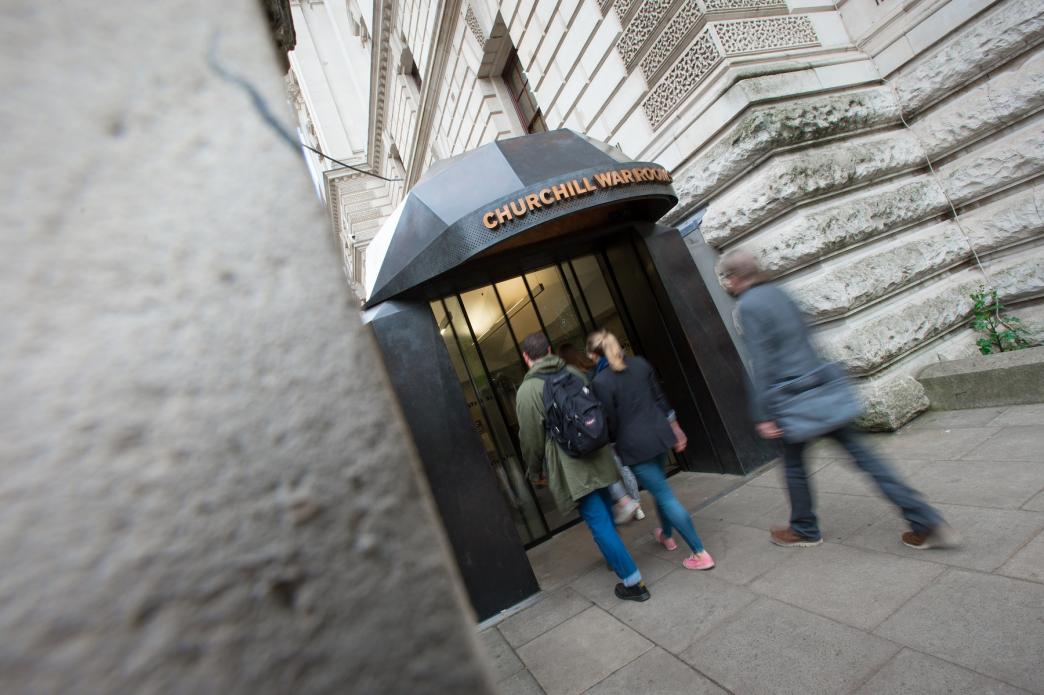
The elusive entrance to the Churchill War Rooms. Photo: Imperial War Museums.
For a tourist-friendly attraction that TripAdvisor users consider the “#2 of 2,060 things to do in London,” the Churchill War Rooms (CWR) Museum is quite difficult to find. I spent longer than I would care to admit in a confused search for the entrance to the CWR, walking down Horse Guards Road and looking for the museum amidst a line of magisterial government buildings.
I searched for it at the top of a broad stone staircase, where I was greeted by a graven bronze statue of an exalted war hero, and along an expansive plaza of official-looking edifices, but I could find no museum entrance. Retracing my steps back onto Horse Guards Road, I finally noticed it. Nestled in between the staircase and the imperious white wall of a grand civic office was a dark bronze entryway, in the shape of a pill made more angular, with a sliding glass doorway the size of an average elevator and, above it, the words “Churchill War Rooms” written in small gold capital letters. This capsular entrance may not have been actively concealing itself, but it certainly did not go to the greatest of lengths to make its presence known.
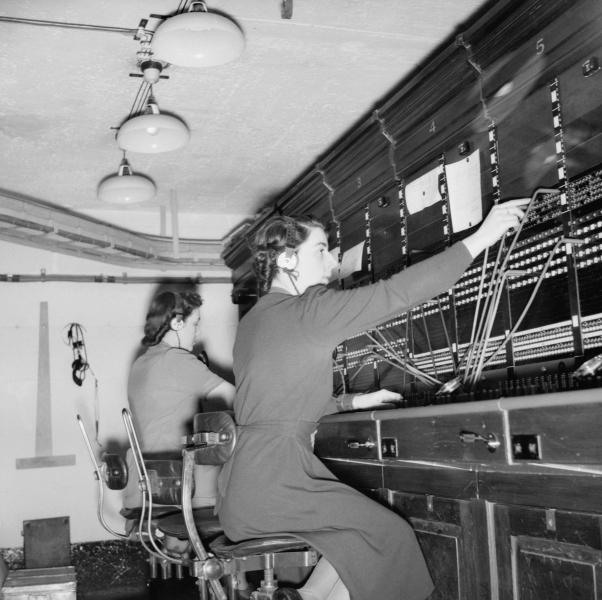
Staff working in the War Rooms. Photo: Imperial War Museums.
The CWR, which opened as a museum in 1984 and is now under the auspices of the Imperial War Museums organization, began its life as the Cabinet War Rooms, a network of underground tunnels, conference centers, bedchambers, and various other strategic spaces used by the uppermost echelons of the British government during World War II. In Churchill’s Bunker: The Cabinet War Rooms and the Culture of Secrecy in Wartime London (2010), military historian Richard Holmes explains that the compound was designed in the late 1930s as a precautionary measure. Upon first visiting the main underground conference room in May 1940, newly-appointed Prime Minister Winston Churchill famously remarked that “this is the room from which I’ll direct the war,” and when the Germans began their Blitz bombing campaign in September, Churchill was proven right. The Cabinet War Rooms quickly became the safest location for tactical deliberations, secure telephone calls, and sometimes even a good night’s sleep. Largely abandoned after the war, the well-preserved complex is now open to the general public, a prime example of a historical site successfully being retrofitted as an engaging, didactic, and tourist-friendly museum.
But wouldn’t one hope that such a broadly-appealing museum would be easier for visitors to locate?
My personal difficulty in finding the entrance led me to wonder what is at stake in the understated nature of the hard-to-find entrance of the CWR. Inspired by Yi-Fu Tuan’s seminal Space and Place: The Perspective of Experience (1977), I began to think about what this inconspicuous entryway signifies as the border between the outside “space” of the governmental plaza and the inside “place” of the war room facility.
Tuan argues that these two concepts of “space” and “place,” though “closely related,” differ in their shades of meaning: “place is security, space is freedom.” These two ideas—place as a safe, defined location, and space as a sprawling expanse—play off of one another, as “from the security and stability of place we are aware of the openness, freedom, and threat of space, and vice versa.”
The different environments on either side of the entrance to the CWR resemble this relationship between space and place. The exterior space surrounding the museum represents a vast, seemingly infinite expanse of civic life. Horse Guards Road is a sequence of homogenous governmental architecture that blends together into one long ceremonious administrative space. It is the undifferentiated bureaucratic heartbeat of the city, a structural manifestation of the countless faceless pencil-pushers, analysts, aides, office workers, secretaries, record-keepers, and politicians of various ranks who probably spend the day there. And the buildings on Horse Guards Road hold not just a feeling of expansiveness but also that latent sense of “threat” with which Tuan characterizes the idea of space. The gleaming white Portland stone—of the looming columns and soaring pediments and monumental staircases and military statue plinths—is imperial in its grandeur and proportions, projecting a quietly intimidating show of strength and power to the small pedestrians below. Thus, through its vastness and its underlying menace, the site in which the capsular bronze entryway to the CWR is situated exudes Tuan’s conception of spatiality.
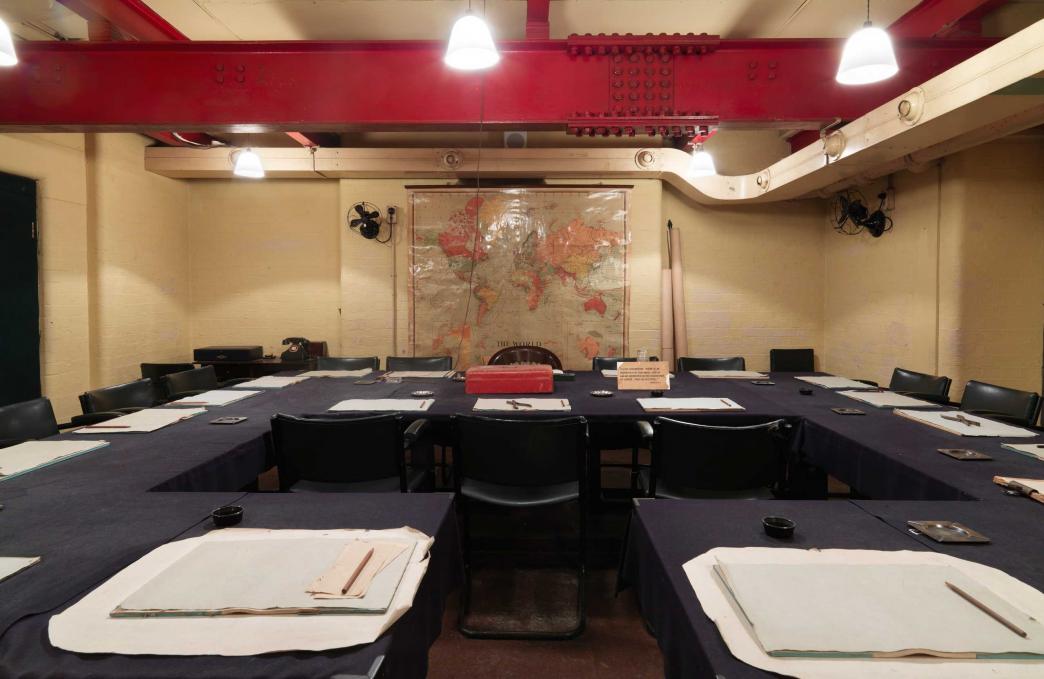
Inside the Churchill War Rooms. Photo: Imperial War Museums.
But the other side of the entryway, and down a flight of stairs into the museum proper, the expansiveness of the aboveground governmental plaza simply does not exist. Low ceilings and cramped quarters abound, and rooms are inordinately small, like scale models of themselves. There is nothing vast, open, or free about this subterranean warren; at some points the hallways are scarcely wide enough to fit two people abreast. The lack of freedom is only intensified by the museumified nature of the modern-day space, as visitors are kept on a strict, singular path and stop in a predetermined order at a few dozen designated audioguide information points. Some areas, like the former sleeping quarters of important government officials, are glassed off, offering the ability to look but not enter. Others, like the sub-basement where the lower-ranking personnel lived, are completely off-limits, with a locked military-grade door impeding the path of access. But, of course, why should we expect to find any trace of freedom here? The CWR is not a space—it is a place.
The CWR epitomizes Tuan’s idea of the “security and stability of place”; it was, after all, built for the explicit purpose of keeping people safe in a specific place while large-scale damage and danger terrorized those in the general space of the city. Perhaps nowhere in the CWR is this sense of security embodied more than in a hallway in which a large hole has been cut in the ceiling to reveal the facility’s physical protection against air raids, a three-meter-thick slab of reinforced concrete. The curatorial decision to open up the ceiling to make this slab visible adds to a visitor’s appreciation of the compound’s safety—hearing about the reinforced concrete on the audio tour allows you to intellectually understand that the bunker is fortified, but seeing it actualizes the distance and protection that lies between the tunnels and street level.
But in addition to the sense of defensive security, at times the CWR almost paradoxically feels endearing and homey. Tuan refers to a place as a “charmed world,” and he also cites the domicile as a prime example of a place; these qualities can be found within the CWR, especially within its pint-sized living quarters. In the room where Clementine Churchill slept, a toothbrush stands in a white cup on the small wooden desk, and a bright pink sheet is tucked neatly into the twin bed. In her husband’s underground bedroom, a chamber pot sits at the foot of the kid-sized bed while maps of the world are plastered on the wall behind—a portrait, of course, of the desperate measures of wartime, but also, if you squint hard enough, perhaps an image of the bedroom of a young would-be adventurer in some children’s story set in the Victorian era. In a sense, the various living quarters in the War Rooms, tiny rectangular slices of domesticity preserved with the furnishings and accoutrements of their wartime use, give us a doll-house view into private, interior life, a “charmed world” of an almost make-believe home. The CWR is, in short, a place, originally used by wartime leaders as a secure bulwark against the threatening open space of a city under fiery siege and now experienced by museumgoers as a cramped and charming representation of its former use.
So, with the governmental plaza at Horse Guards Road conceived of as a space, and the CWR as a place, the capsular entryway that separates these two areas must take on a particularly important mediating role.

The reinforced bunker of the Churchill War Rooms. Photo: Imperial War Museums.
Designed in 2012, the bronze entrance, according to a press release by the architects, is intended to “act as a beacon... while improving the visitor experience and way-finding for the public” and to “contribute positively to the identity and visibility” of the museum. When I first read this press release, I felt quite embarrassed by my own navigational skills—how could I have had such difficulty locating an entrance specifically intended to facilitate “way-finding” and “visibility”? But I stopped chastising myself when I came across a photograph of the old entryway, a nondescript bunker-like grey-brick structure, virtually invisible amongst the surrounding mass of Portland stone, with a small sign perpetually obscured by the shadows of a few overhanging sandbags. Almost anything, in comparison to this nearly invisible façade, could be considered a “beacon.” The director of the CWR, in fact, has noted that this prior entrance was the cause of “so many years of potential visitors being confused, thinking the entrance was just to another Government [sic] office.”
This information sheds light on the interplay between space and place that occurs at that pill-shaped, elevator-sized portal. If the goal was truly to create a “beacon” of “identity and visibility,” surely the architect could have come up with something to accomplish this task better than the actual design implemented. A large, brightly-colored sign on the top of the entrance, for instance, instead of the classy yet understated gold lettering. Or an entryway that protrudes beyond the stairs, instead of remaining tucked in behind them. Heck, even decorating the pedestrian pathway on Horse Guards Road with a colossal blown-up photograph of Prime Minister Churchill, with his signature “V for victory” fingers pointing toward the museum—what could be more of a beacon than that? But instead, this so-called “beacon,” which does mitigate the practical problem of allowing would-be visitors to find the museum, is not actually much of a beacon at all. The entrance is still difficult to find; if its primary goal is to be visible, it has failed in that charge.
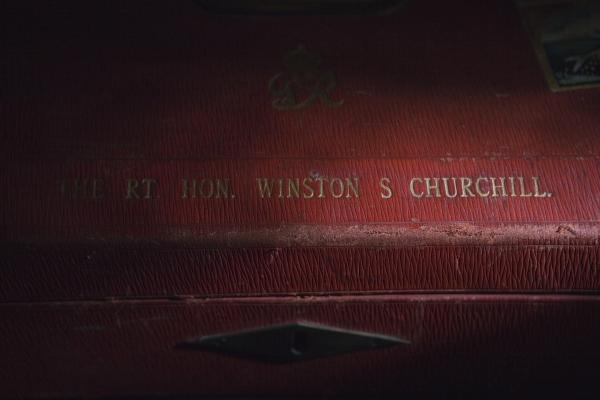
Winston Churhill's despatch box on view at the Churchill War Rooms Museum. Photo: Imperial War Museums.
This idea leads me to believe that, although the promotional material may advertise the current entrance as a way-finding tool, there was a conscious or subconscious architectural decision not to make this entrance as locatable as possible. A decision, in other words, to avoid distinguishing too clearly between the exterior government buildings and the interior war room museum, between space and place. Tuan explains that sometimes, “what begins as undifferentiated space becomes place we get to know it better,” and it seems that this very process occurs when you try to find the entrance to the CWR. The place is hidden within the space; as you walk along Horse Guards Road, you feel like you are looking merely at a mass of “undifferentiated space.” But eventually, you “get to know [the space] better,” navigating around the plaza, perhaps walking up the stairs or around a few buildings. And then, finally, you come across the place within the space, the entrance that has been hitherto visually concealed within the exterior space. Certainly, this phenomenon would have been more dramatic with the old entrance, which was more completely hidden and difficult to find, but this exercise of finding the place still occurs, albeit in a less pronounced fashion, even with the entrance designed for the practical purpose of being visible to “potential visitors.”
On one level, the retention of this effortful place-finding primes visitors to experience a place that played the specific historical role that the War Rooms originally did. The Cabinet War Rooms were intended to be, above all, secret—nobody, save for the people who had the security clearance to work there, was to know that they existed at all. In fact, this secrecy was the greatest source of the facility’s safety. Even at the thickest point of the three-meter defensive concrete slab, the bunker was vulnerable to a direct hit from a 500-pound bomb—which, if the enemy were to find out where the facility was located, was a very real possibility during the Blitz. Therefore, the War Rooms survived the bombings of London unscathed because they were kept a secret, because the Luftwaffe was unable to differentiate this particular place from the general expansive space of London. When museumgoers today are forced to do a bit of work to find the CWR museum within the mass of governmental architecture on Horse Guards Road, the entire original purpose of the Cabinet War Rooms is being implicitly transmitted to them. They come to understand, without knowing it, without even stepping foot into the museum, exactly why the Cabinet War Rooms were important and effective in their historical context: because they were hard to find.
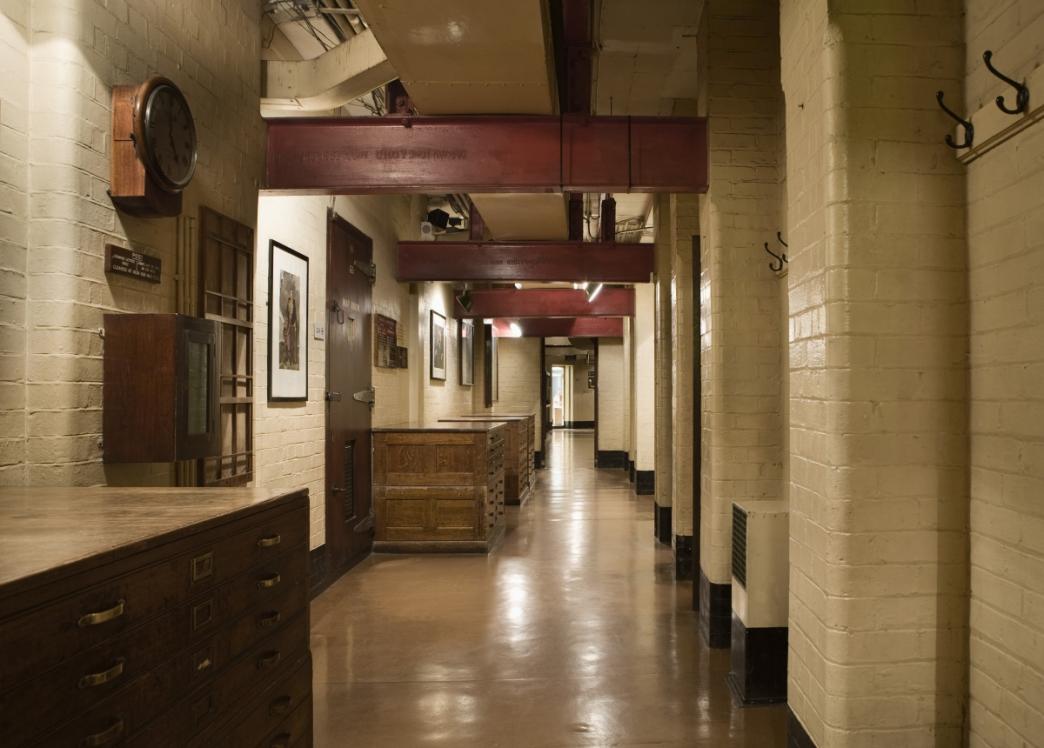
The main hallway of the Churchill War Rooms. Photo: Imperial War Museums.
But this notion, that what we experience in the present can somehow tell us something about how a place functioned in the past, actually leads us to an equally significant, and perhaps even more interesting, effect of place-finding at the CWR entrance. Anthropologist Keith Basso, in the introduction to Wisdom Sits in Places: Landscape and Language among the Western Apache (1996), muses on the idea of the past as a foreign country that we are capable of traveling to and from. About the significance of locations in which prior events have occurred, Basso writes that “many of these places [of the past] are also encountered in the country of the present as material objects and areas, naturally formed or built, whose myriad local arrangements make up the landscapes of everyday life. But here, now, in the ongoing world of current concerns and projects, they are not apprehended as reminders of the past.” Because the CWR is somewhat difficult to find, but ultimately findable, it in fact serves as an example of how easy places of the past are to miss. The CWR helps to “make up the landscapes of everyday life” in London; lying beneath a major center of governmental power, it is entwined with the structural foundations and eventual fate of the everyday bureaucracy that carries on above. Nevertheless, “here, now, in the ongoing world of current concerns and projects,” it is incredibly easy to “not apprehend” these subterranean strategy chambers as “reminders of the past.” Each day, hundreds if not thousands of people—tourists, locals, government employees, joggers, and bicyclists—pass by the CWR without realizing what is underneath them.
And for the people who actually do end up apprehending the CWR as a reminder of the past, they often apprehend it after having struggled, at least momentarily, to do so. If I wasn’t looking for it, I wouldn’t have known it was there—that is what the inconspicuous pill-shaped entrance makes visitors realize. And this revelation is one that far transcends the story of Churchill and his War Cabinet during the Blitz. How much more history (and how much that, unlike the triumphant tale of Churchill and his heroic resolve during his nation’s dark hours, does not fit the prevailing metanarratives of the day) continually passes before our eyes unnoticed? How many places do we fail to perceive when we traverse the expansive spaces that comprise our daily lives? How much lies beneath our very feet, buried by the never-ending strata of the years, covered by a patina of age, ensconced in a tomb of time, without its own elevator-sized bronze capsular entryway to a museum to let us know? How much of the past do we miss?
